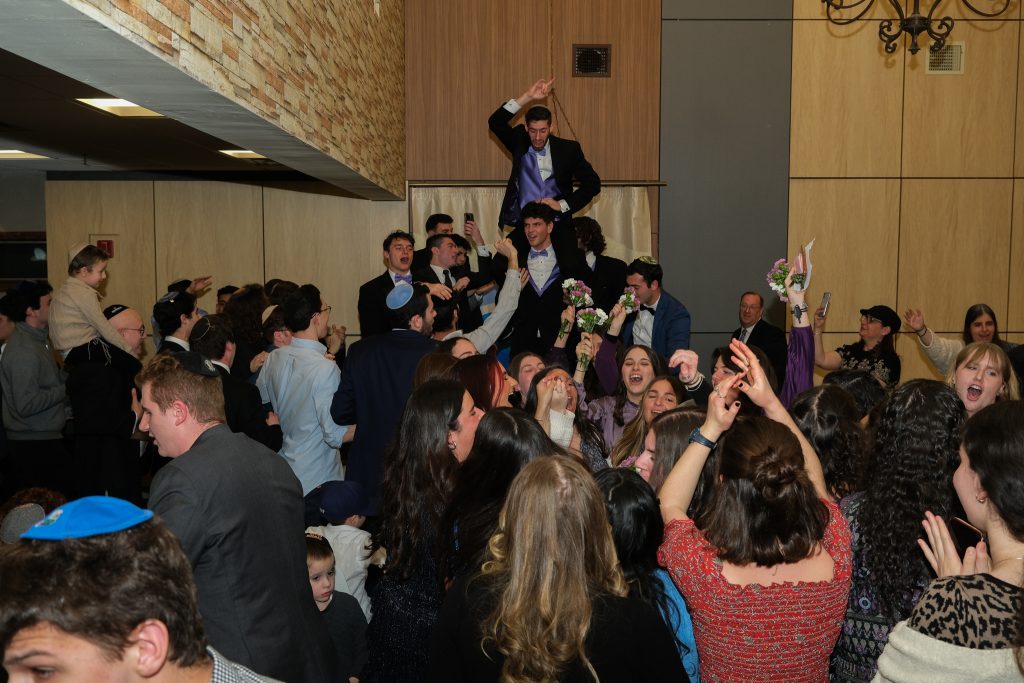From an abundant smorgasbord to enthusiastic extended family members, Chabad at Binghamton’s Mock Wedding was a brilliant representation of Jewish values and community.
This past Sunday, members of Chabad and their friends and families came together to attend a mock Jewish wedding. The energy of camaraderie was felt throughout, as everyone from the Rabbi to the students-turned-grandparents were proudly celebrating Jewish culture, tradition and humor.
Leila Tilem, a member of Chabad’s general board (G-Board) and a freshman majoring in philosophy, politics and law, shared what component of the wedding she was most eagerly anticipating.
“I was definitely most excited for the chuppah portion because I was looking forward to seeing how the cast would enhance tradition with humor, and they did an incredible job,” Tilem wrote in an email. “I hope attendees take away the beauty in a traditional Jewish wedding and want to have one of their own.”
The chuppah segment of the wedding was a testament to Jewish tradition as well as the community’s appreciation for quality comedy. While demonstrating Jewish ceremonial practices, the mock aspect of the wedding gave cast members the room to channel their inner humor. The groomsmen, for instance, walked down the aisle on each other’s shoulders and the grandparents limped to the beat of Queen’s “We Will Rock You.”
Jake Nussbaum, education chair of Chabad Binghamton, the Rabbi in the mock wedding and a junior majoring in psychology, gave a speech in the beginning of the ceremony explaining the religious symbolism of the chuppah. A chuppah is a Jewish wedding canopy that encompasses the bride, the groom and their immediate families. Notably, the chuppah is open on all four sides, resembling the welcoming home that the hypothetical newlyweds’ would soon build together.
Part of emulating a traditional Jewish wedding meant dressing cast members in clothing that their characters would have worn had it been a real ceremony. Sam Weingard, president of Chabad Binghamton and a senior majoring in philosophy, politics and law, offered the religious significance of the bride’s veil.
“The veil represents a time in the Bible when the matriarch Leah and the matriarch Jacob got married by accident, because at the time Jacob was supposed to marry Leah’s sister, Rachel,” Weingard said. “However, Rachel — to save her older sister who was unmarried — from embarrassment, switched places with her at the last minute which meant Jacob ended up marrying Leah instead. That is why the bride wears a veil, so that the groom can check and see that it is indeed her and the marriage ceremony can continue.”
In addition to the religious value of the bride’s veil, there were numerous other symbolic customs demonstrated throughout the wedding, such as the breaking of the glass. Dahlia Kleinhaus, a member of Chabad’s G-Board and a freshman majoring in biology, explained the meaning of this practice and why it is important to acknowledge Jewish history in a traditional wedding.
“There are various Jewish rituals and traditions that happen during the ceremony,” Kleinhaus wrote in an email. “For example, in the last part of the ceremony the groom breaks a glass by stepping on it. It symbolizes that even though the wedding is a moment of great joy, one must always remember the destruction of the Temple in Jerusalem in 70 CE.”
In order to ensure that the event addressed these crucial components of a traditional Jewish wedding, Chabad members were committed to an extensive preparation period. Michal Levine, the major programs coordinator of Chabad Binghamton and a junior majoring in Judaic studies, provided a breakdown of what the months leading up to the event looked like for those involved.
“This event was the product of much hard work and careful consideration that every detail went smoothly,” Levine wrote in an email. “We started our weekly Spearhead meetings the first week of this semester which was approximately a month before. As the event got closer we had a few committee meetings to start PR, Recruitment and Decor aspects of the event. We then spent Saturday night and Sunday preparing the food, setting up all the rooms, running through the event and cast prep.”
The time and energy that Chabad devoted to the mock wedding made for an event that balanced both accuracy and entertainment. While the ceremony may have been a mock wedding, there was nothing mock about the real sense of community that was present throughout.
Weingard described some of the Jewish values that were authentic products of such a celebratory event.
“The singing, the dancing, the simcha, the excitement, all of that is part of a real [Jewish] wedding,” Weingard said. “Simcha is the Hebrew word for happiness. We say simcha every time we are at a blessed and happy occasion in Jewish life.”



